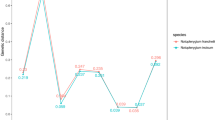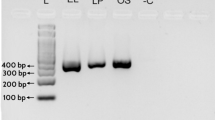Abstract
Kratom is the leaves of Mitragyna speciosa (Rubiaceae). Recently, kratom has been sold in street shops or on the Internet in Japan for the purpose of abuse due to its opium-like effects. In this study, we investigated the botanical origin of the commercial kratom products using the internal transcribed spacer (ITS) sequence analysis of rDNA in preparation for future regulation of this product. In addition, a previously reported method to authenticate the plant, utilizing polymerase chain reaction-restriction fragment length polymorphism (PCR-RFLP) was applied to the same products in order to estimate the method’s accuracy and utility. The ITS sequence analysis of the commercial kratoms revealed that most of them were derived from M. speciosa or closely related plants, while the others were made from the same tribe plant as M. speciosa. The reported PCR-RFLP method could clearly distinguish kratoms from the other psychoactive plants available in the Japanese markets and also from related plants. The authentication method is considered to be useful for the practical regulation of the plant due to its wide range of application, high accuracy and simplicity.

Similar content being viewed by others
Notes
The revision of the Pharmaceutical Affairs Law (Jun. 14, 2006), Law No. 69 (2006).
Ordinance No. 14 (Feb. 28, 2007), Ministry of Health, Labour and Welfare, Japan. Ordinance No. 146 (Dec. 12, 2007), Ministry of Health, Labour and Welfare, Japan. Ordinance No. 172 (Dec. 17, 2008), Ministry of Health, Labour and Welfare, Japan.
References
Takayama H, Aimi N, Sakai S (2000) Chemical studies on the analgesic indole alkaloids from the traditional medicine (Mitragyna speciosa) used for opium substitute. Yakugaku Zasshi 120:959–967
Takayama H (2004) Chemistry and pharmacology of analgesic indole alkaloids from the rubiaceous plant, Mitragyna speciosa. Chem Pharm Bull 52(8):916–928
Matsumoto K, Horie S, Ishikawa H, Takayama H, Aimi N, Ponglux D, Watanabe K (2004) Antinociceptive effect of 7-hydroxymitragynine in mice: discovery of an orally active opioid analgesic from the Thai medicinal herb Mitragyna speciosa. Life Sci 74:2143–2155
Maruyama T, Kawahara N, Fukiharu T, Yokoyama K, Makino Y, Goda Y (2005) DNA and chemical analyses of commercial fly agaric-related products. Shokuhin Eiseigaku Zasshi 46:49–54
Maruyama T, Kawahara N, Yokoyama K, Makino Y, Fukiharu T, Goda Y (2006) Phylogenetic relationship of psychoactive fungi based on rRNA gene for a large subunit and their identification using the TaqMan assay (II). Forensic Sci Int 163:51–58
Maruyama T, Kamakura H, Kikura-Hanajiri R, Goda Y (2008) Authentication and ultra performance liquid chromatography (UPLC)/MS analysis of magic mint, Salvia divinorum and its related plants. Yakugaku Zasshi 128:179–183
Sukrong S, Zhu S, Ruangrungsi N, Phadungcharoen T, Palanuvej C, Komatsu K (2007) Molecular analysis of the genus Mitragyna existing in Thailand based on rDNA ITS sequences and its application to identify a narcotic species: Mitragyna speciosa. Biol Pharm Bull 30:1284–1288
Kitajima M, Nakayama T, Kogure N, Wongseripipatana S, Takayama H (2007) New heteroyohimbine-type oxindole alkaloid from the leaves of Thai Mitragyna hirsuta. J Nat Med 61:192–195
Thompson JD, Higgins DG, Gibson TJ (1994) CLUSTAL W: improving the sensitivity of progressive multiple sequence alignment through sequence weighting, position-specific gap penalties and weight matrix choice. Nucleic Acids Res 22:4673–4680
Razafimandimbison SG, Bremer B (2002) Phylogeny and classification of Naucleeae s.l. (Rubiaceae) inferred from molecular (ITS, rbcL, and trnT-F) and morphological data. Am J Bot 89:1027–1041
Sang T, Crawford DJ, Stuessy TF (1995) Documentation of reticulate evolution in peonies (Paeonia) using internal transcribed spacer sequences of nuclear ribosomal DNA: implications for biogeography and concerted evolution. Proc Natl Acad Sci USA 92:6813–6817
Phillipson JD, Hemingway SR, Ridsdale CE (1982) The chemotaxonomic significance of alkaloids in the Naucleeae s.l. (Rubiaceae). J Nat Prod 45:145–162
Acknowledgments
We thank Ms. Latifah BT. HJ. Idris for kindly supplying the kratoms from Malaysia. This research was supported by grants from the Ministry of Health, Labour and Welfare, Japan.
Author information
Authors and Affiliations
Corresponding author
Electronic supplementary material
Below is the link to the electronic supplementary material.
Rights and permissions
About this article
Cite this article
Maruyama, T., Kawamura, M., Kikura-Hanajiri, R. et al. The botanical origin of kratom (Mitragyna speciosa; Rubiaceae) available as abused drugs in the Japanese markets. J Nat Med 63, 340–344 (2009). https://doi.org/10.1007/s11418-009-0325-9
Received:
Accepted:
Published:
Issue Date:
DOI: https://doi.org/10.1007/s11418-009-0325-9




